MSI GeForce GTX 760 HAWK 2 GB Review

We had tested one of the most interesting GeForce 760 graphics card from MSI. The card has exciting hardware and a very good performance which looks like a GeForce GTX 770.
There are as many as eight versions of the GeForce GTX 760 graphics card currently offered by MSI. Among them we can see copies of the reference design as well as pre-overclocked Gaming series models. These cards vary in the amount of onboard memory and cooling systems. We guess the most interesting of them is the recently released MSI GeForce GTX 760 HAWK 2GB (N760 HAWK), which is the peak of MSI’s GeForce GTX 760 series. The graphics card incorporates the best solutions, some of which are quite unexpected for a product of its class. We’ll tell you all about them in this review.
MSI GeForce GTX 760 HAWK 2 GB (N760 HAWK) Closer Look
Technical Specifications and Recommended Pricing
The technical spcifications of the graphics cards reviewed today are listed in the following table side by side with those of the reference GeForce GTX 770 from Nvidia and MSI GeForce GTX 760 Gaming:
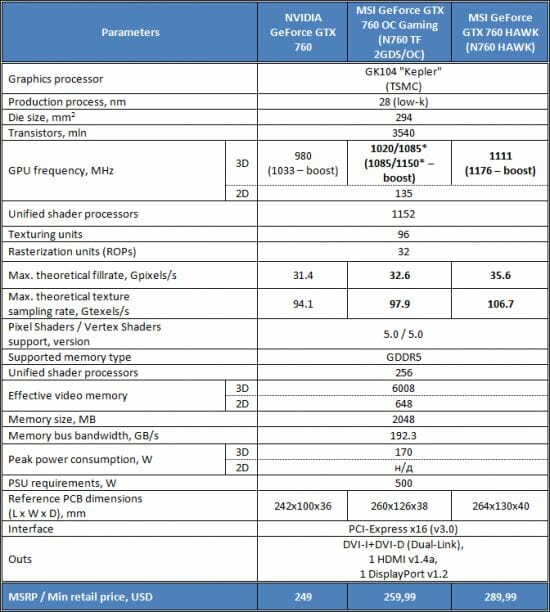
Packaging and Accessories
The packaging of our sample was spoiled by the delivery service, so we’ll show you its photo from the official website:
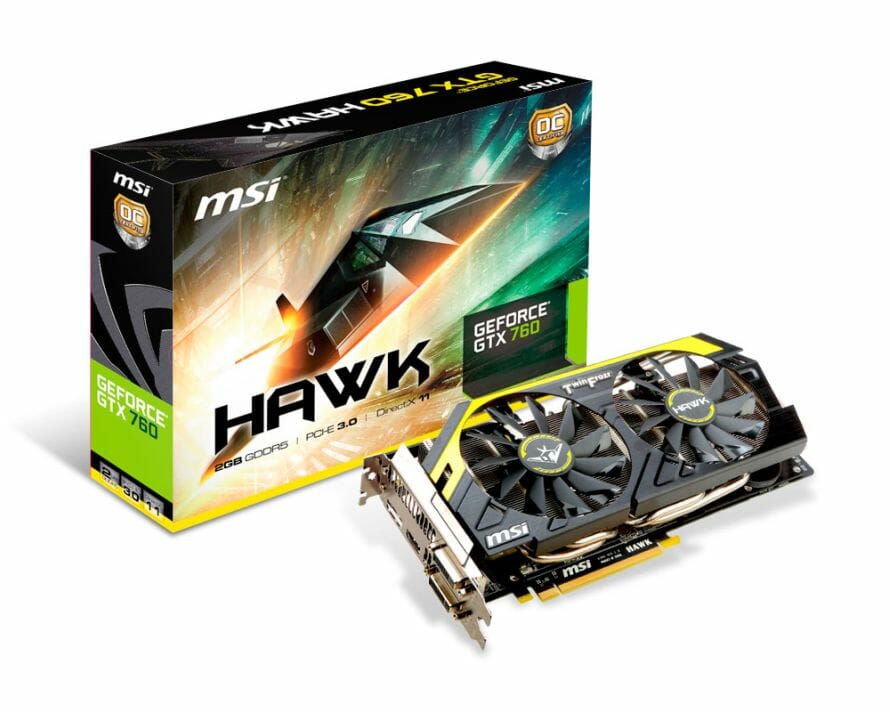
There’s a picture on the box showing a military aircraft tearing through the air. As usual, the product’s system requirements and key features are detailed on the back of the box.
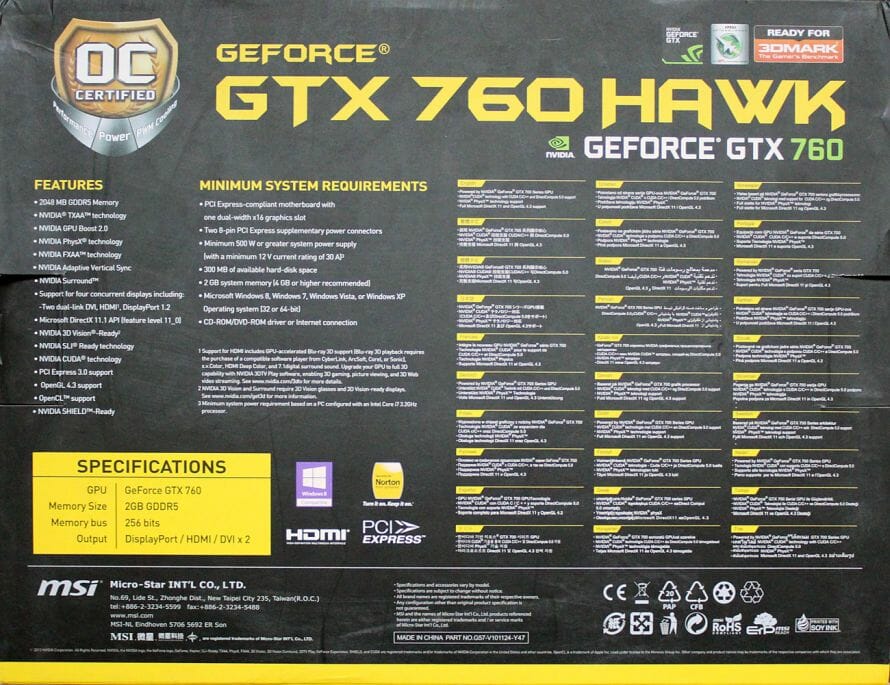
The top cover can be flipped back, so you can read a description of each component. The advantages of this graphics card over the reference GeForce GTX 760 are indicated in decibels and degrees:
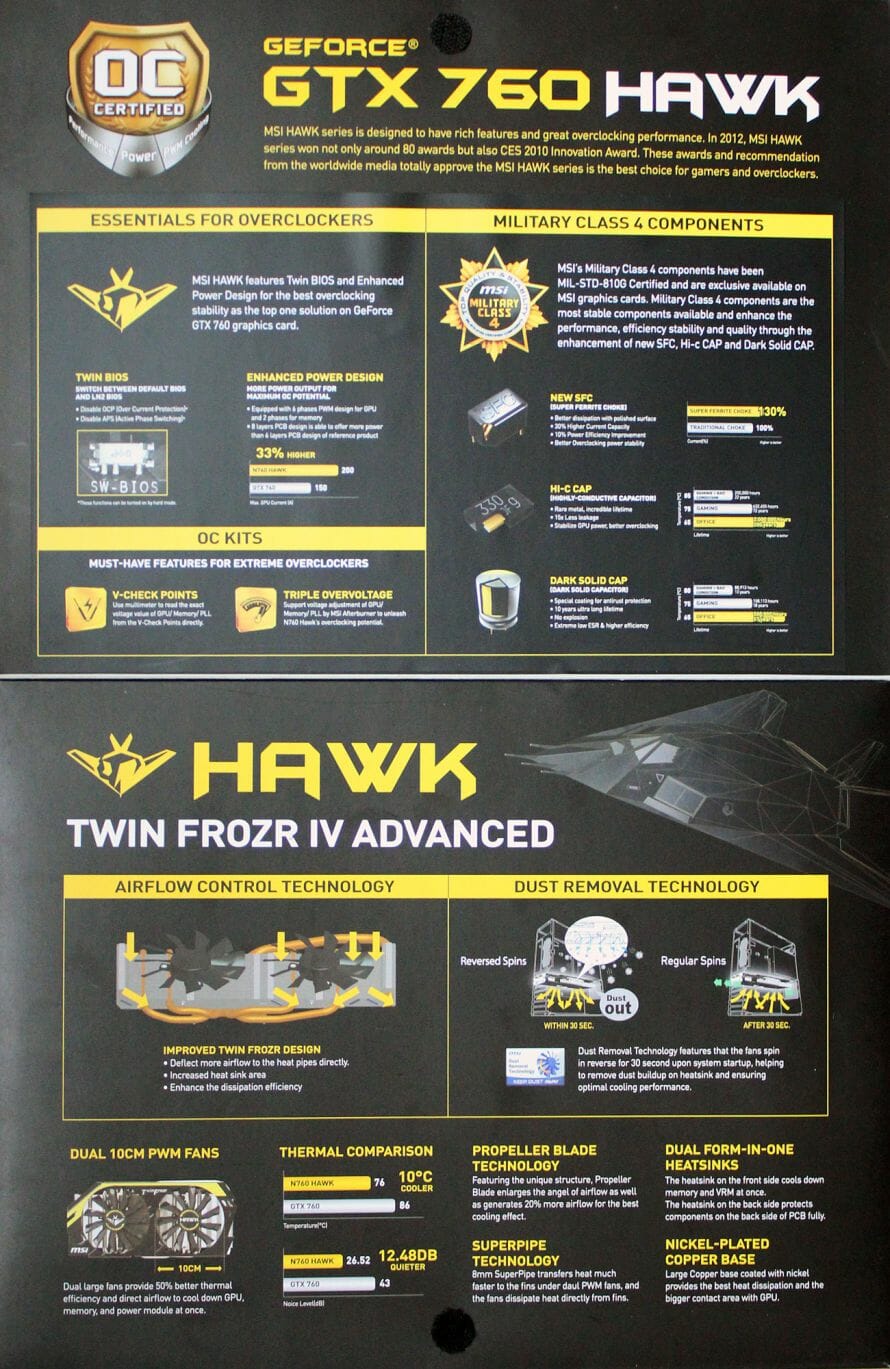
The box has two compartments. The main one contains the card, additionally protected with a polyurethane wrap. On top of it, there is a flat box with accessories which include two power adapters, a DVI->D-Sub adapter, a CD with drivers and utilities, three short cables with connectors for a multimeter, and a brief installation guide.
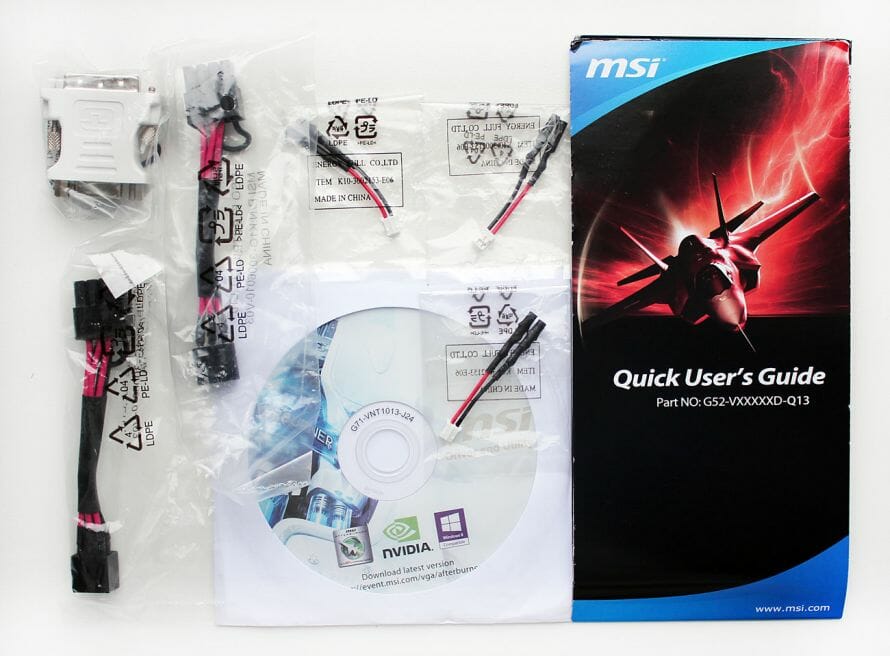
Manufactured in China, the card comes with a 3-year warranty. The MSI GeForce GTX 760 HAWK is priced at $290, which is about $40 higher than the price of the reference version.
PCB Design and Features
The card measures 264x130x40 mm. The face side of the PCB is covered by the cooler’s two 100mm fans and metal casing with a bright yellow stripe along the top.
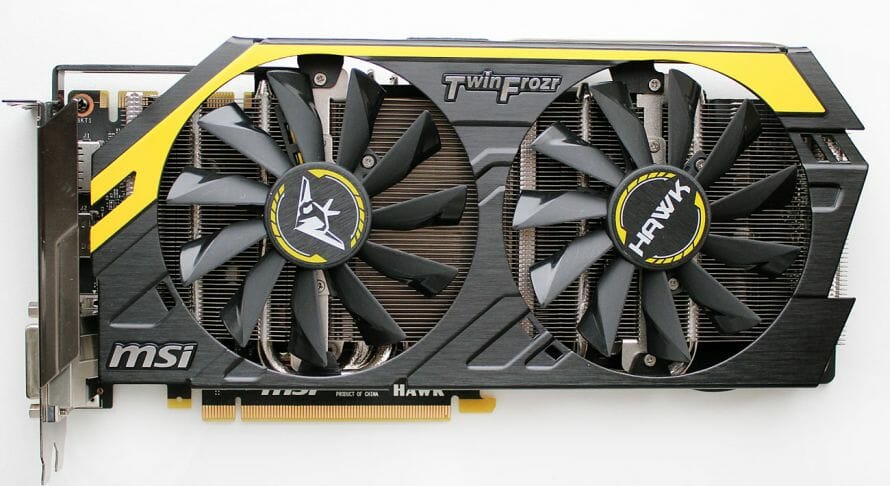
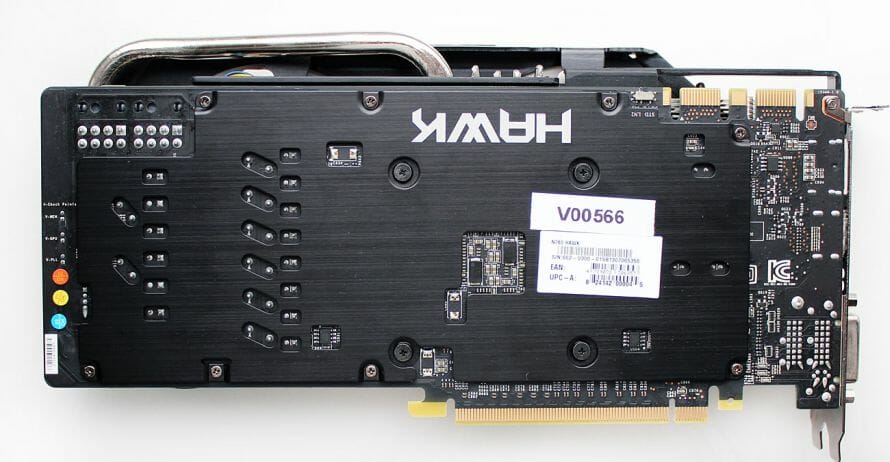
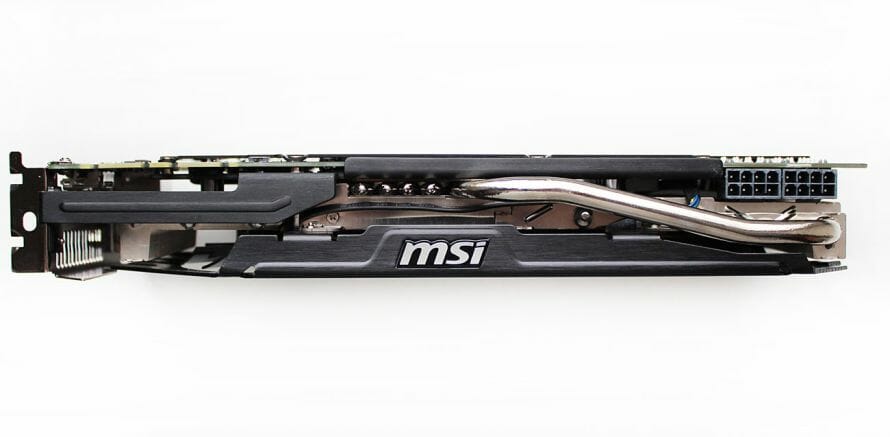
There’s a decorative metal plate on the reverse side of the PCB. It has no contact with any of the PCB components. All of the card’s connectors are neatly covered with plastic caps.
The MSI GeForce GTX 760 HAWK is equipped with four outputs: dual-link DVI-I and DVI-D connectors, an HDMI 1.4a, and a DisplayPort 1.2. There’s a vent grid in the mounting bracket to exhaust some of the hot air out of the computer case.
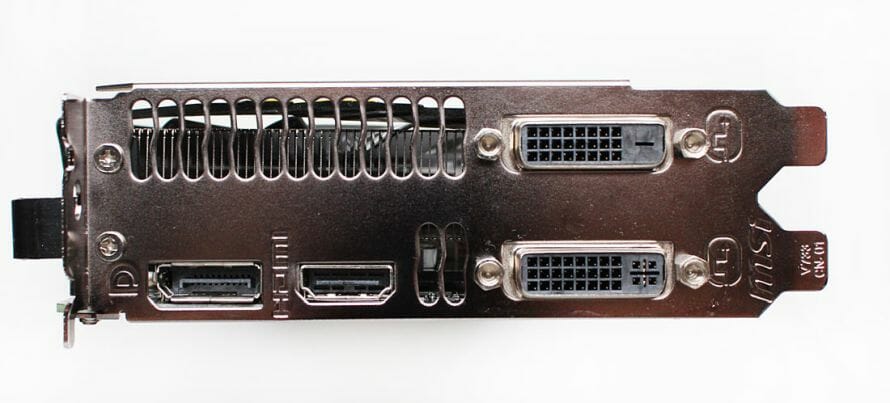
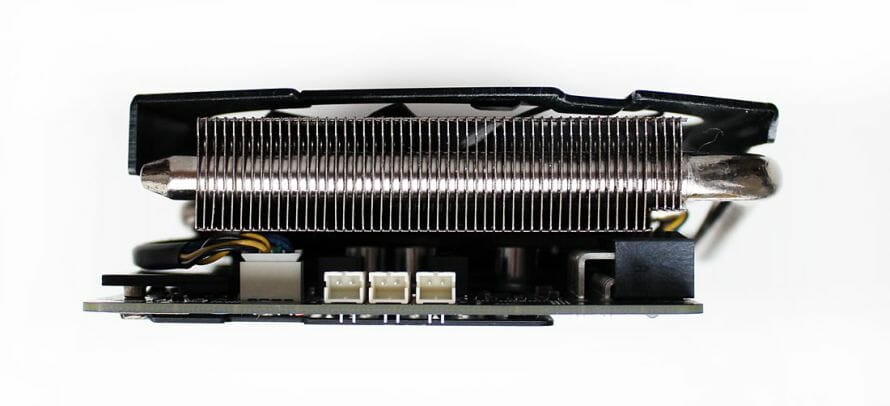
Like a regular GeForce GTX 760, the MSI card has two SLI connectors. The power connectors differ from the reference card’s, though:
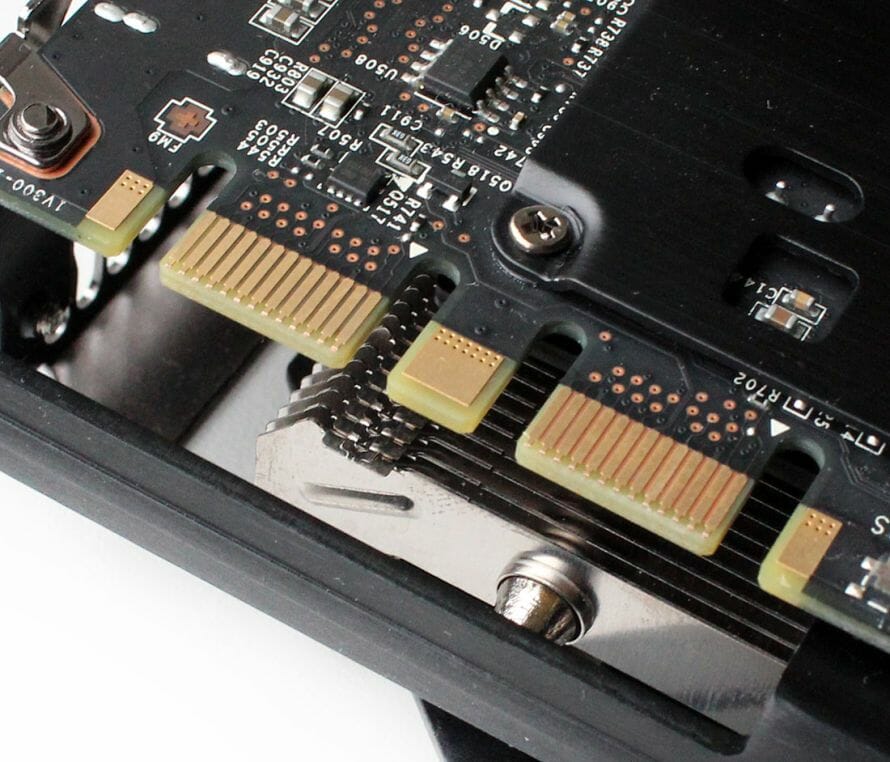
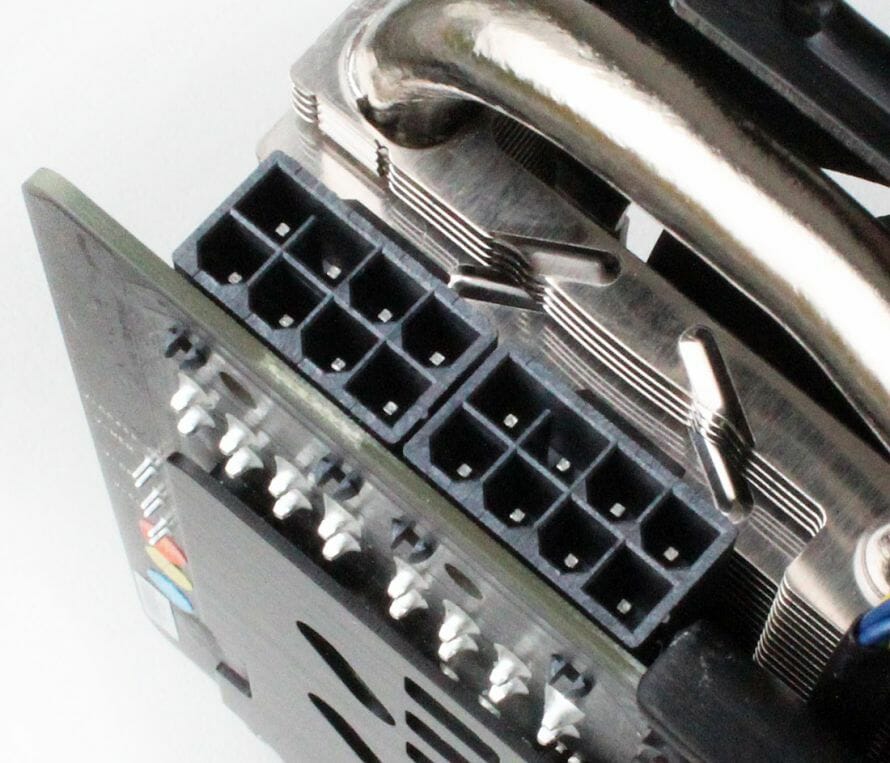
Instead of two 6-pin power connectors, the MSI GeForce GTX 760 HAWK has two 8-pin ones, so we can expect it to have an improved power system and pre-overclocked frequencies. On the other hand, the peak power consumption of this card is specified to be 170 watts, just like with the reference GTX 760.
It was easy to take the massive cooler off because it was only secured with four screws around the GPU. Below it, we found a metal plate that was meant to cool the power transistors and memory chips.
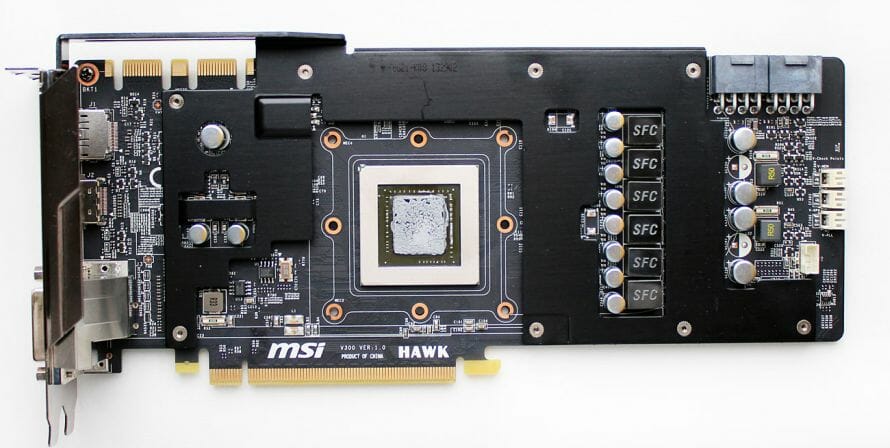
Take note of the stiffness rib at the top of the PCB. It will block both SLI connectors if you use inflexible connecting bridges and prevent you from using the card in 3-way SLI configurations.
Taking both metal plates off, we can have a closer look at the PCB design and components:
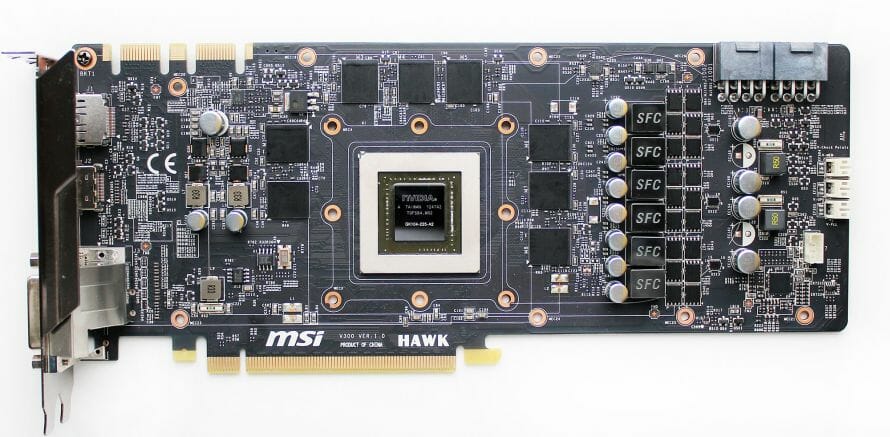
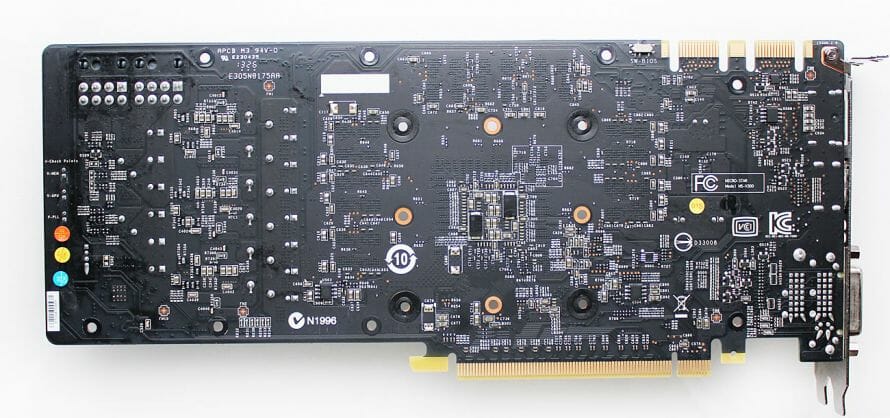
The MSI GeForce GTX 760 HAWK features premium Military Class IV components complying with the American military standard MIL-STD-810G. We can see here aluminum-core solid-state capacitors with ultra-low resistance and 10-year service life, economical Hi-c capacitors, and Super Ferrite Chokes with 20% higher energy efficiency and 30% higher current capacity compared to ordinary chokes.
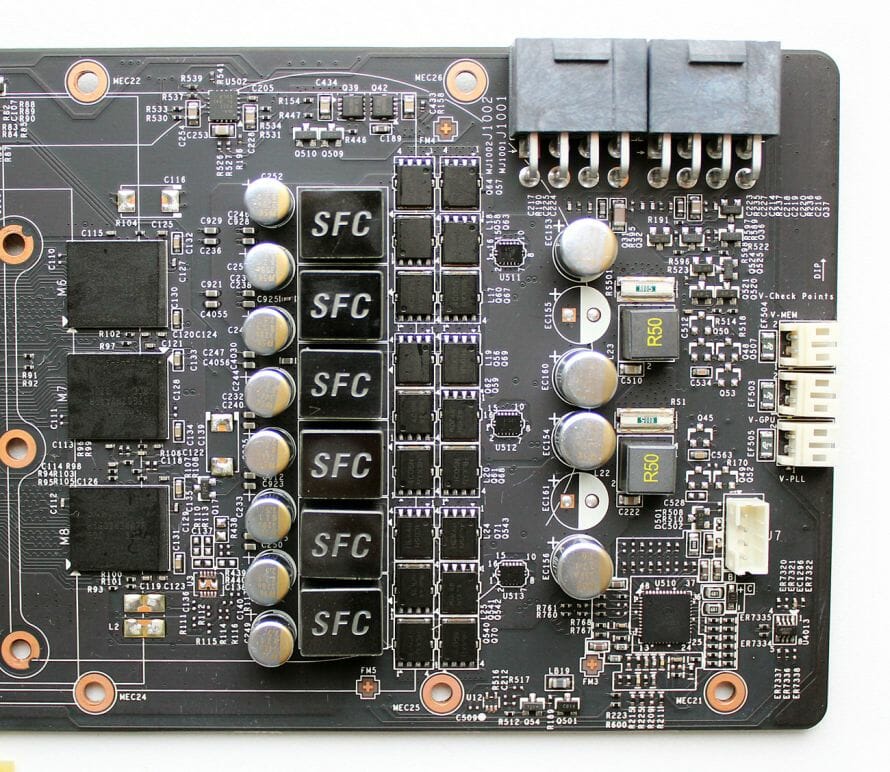
The GPU power system incorporates six phases managed by an NCP4206 controller from ON Semiconductor.
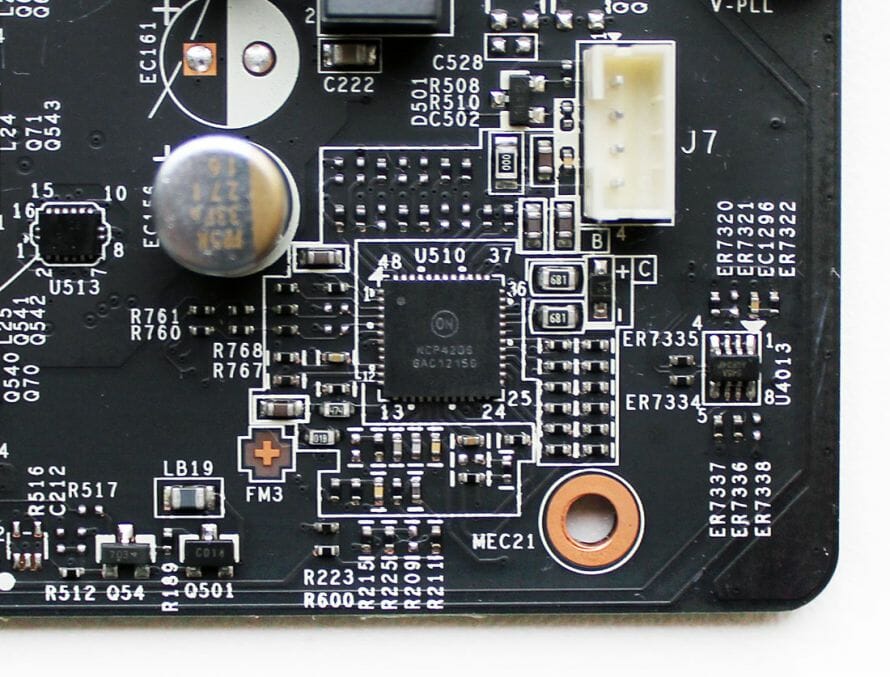
There are two more power phases for the graphics memory and PLL.
Besides the customized PCB, the HAWK features dual BIOS (with LN2 settings for extreme overclocking) and three pairs of check points for measuring GPU, memory and PLL voltage.
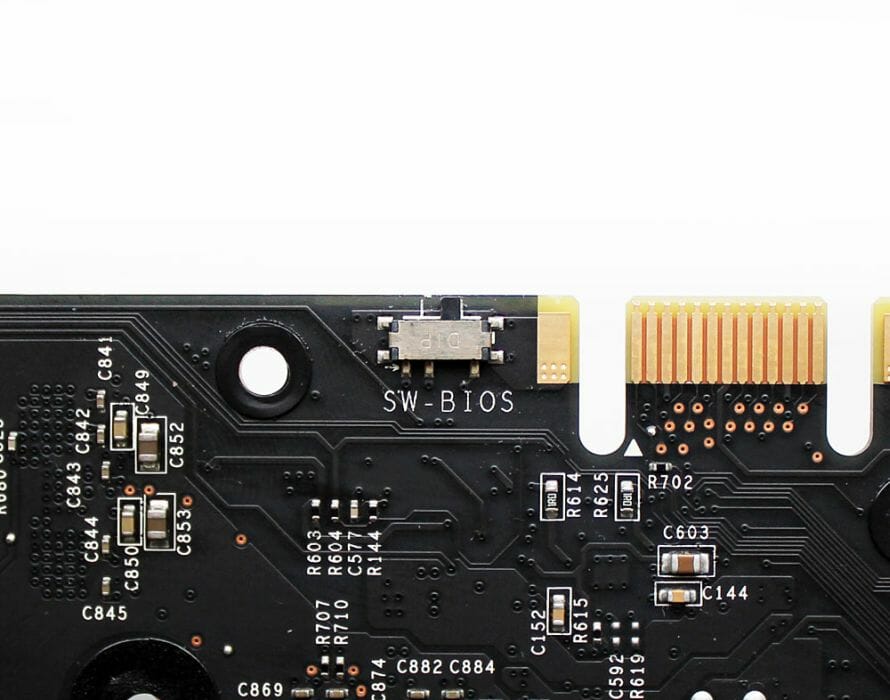
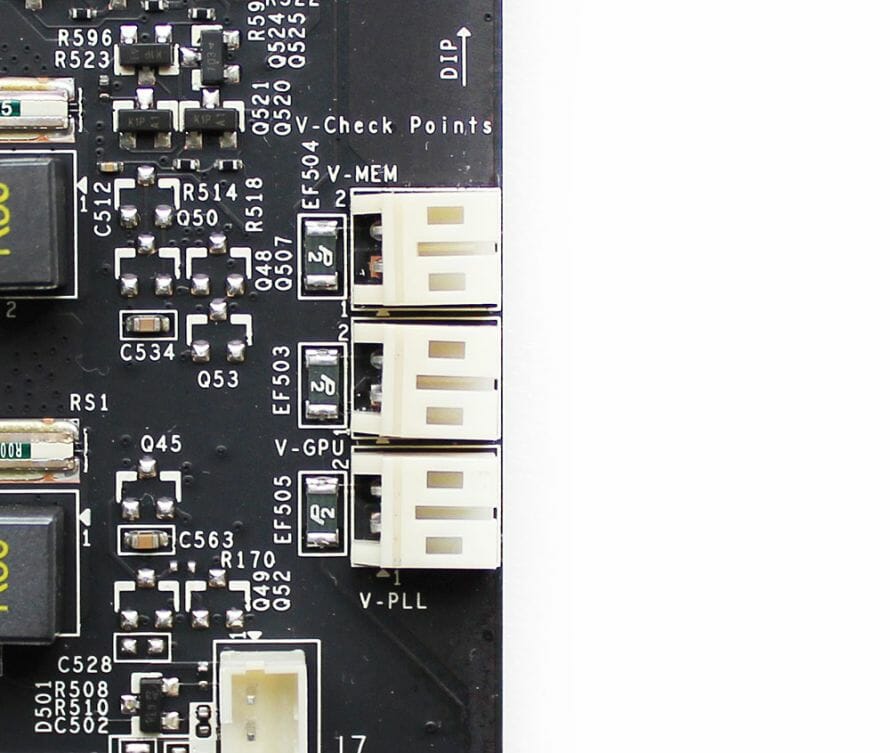
These features are customary on the MSI Lightning series which includes expensive products, so it is quite extraordinary that the MSI GeForce GTX 760 HAWK has them as well.
The 28nm GK104 GPU is revision A2. It was manufactured in Taiwan on the 47th week of 2012.
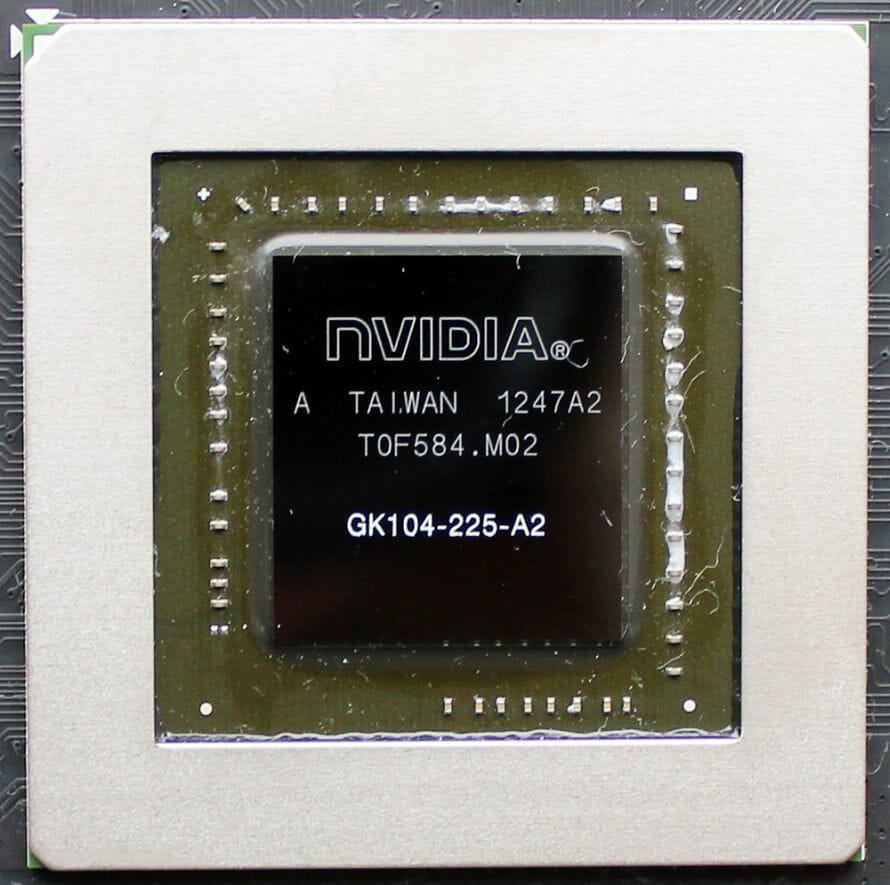
Its base clock rate is 1111 MHz in 3D mode and can be boosted to 1176 MHz (+13.4% to the reference card’s frequency). According to our monitoring data, the peak frequency was as high as 1254 MHz. The GPU clock rate is dropped to 135 MHz in 2D mode and the voltage is lowered from 1.175 to 0.863 volts.
The ASIC quality of our card’s GPU is 79%:
It is quite a high level of quality for a GK104 chip.
The MSI GeForce GTX 760 HAWK comes with 2 gigabytes of GDDR5 memory in eight FCBGA-packaged chips from Hynix (H5GQ2H24AFR R0C):
The memory chips are rated for 6000 MHz, and that’s exactly the memory frequency of the MSI GeForce GTX 760 HAWK. In 2D applications the memory frequency is lowered to 648 MHz.
Thus, the MSI GeForce GTX 760 HAWK has the following specifications by default:
Twin Frozr IV Advanced: Efficiency and Noise Level
The MSI GeForce GTX 760 HAWK is equipped with MSI’s exclusive Twin Frozr IV Advanced cooler.
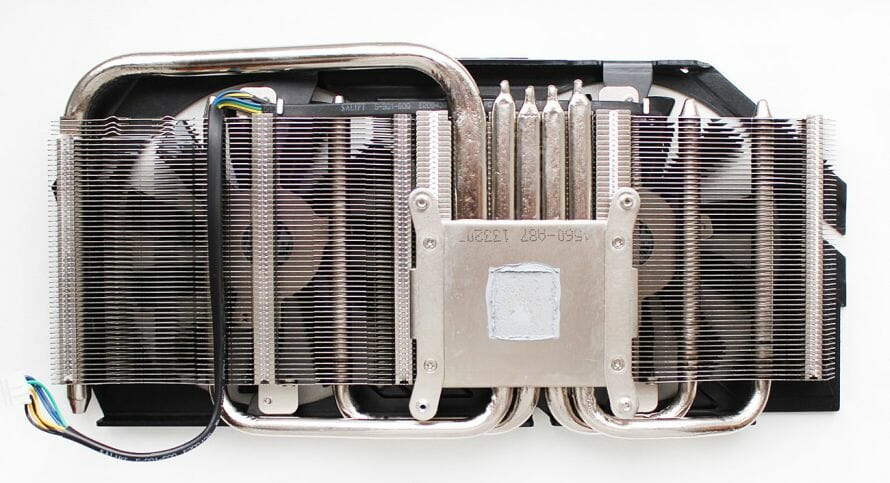
The large aluminum heatsink is pierced by five heat pipes, four of which are 6 mm in diameter. The fifth pipe is 8 mm. Everything is nickel-plated.
The cooler can be easily taken apart:
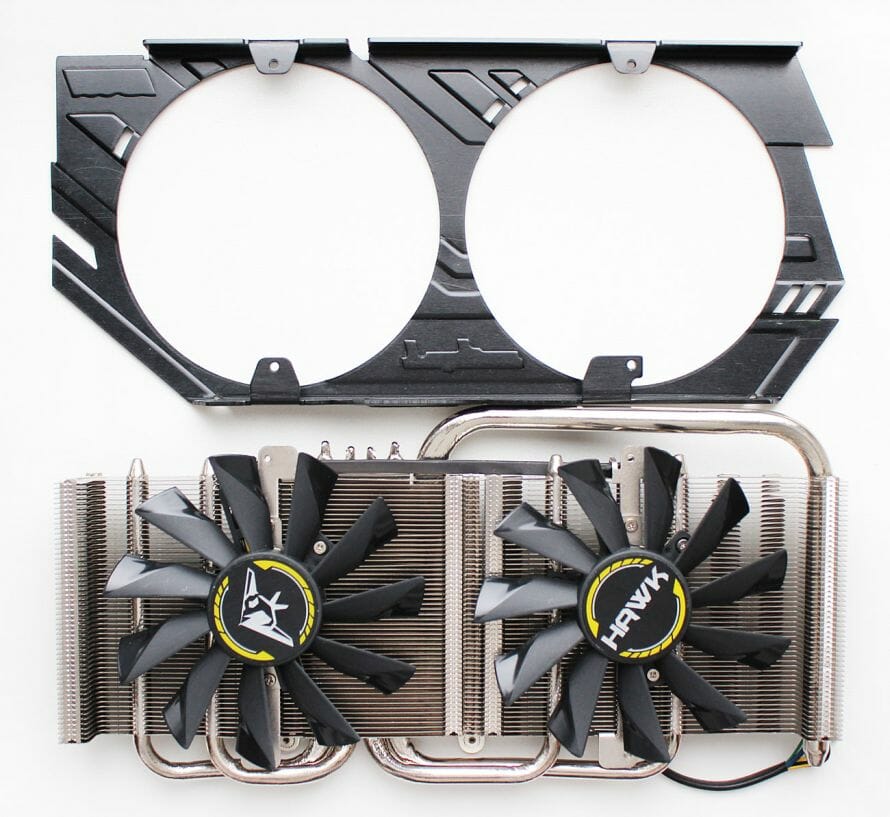
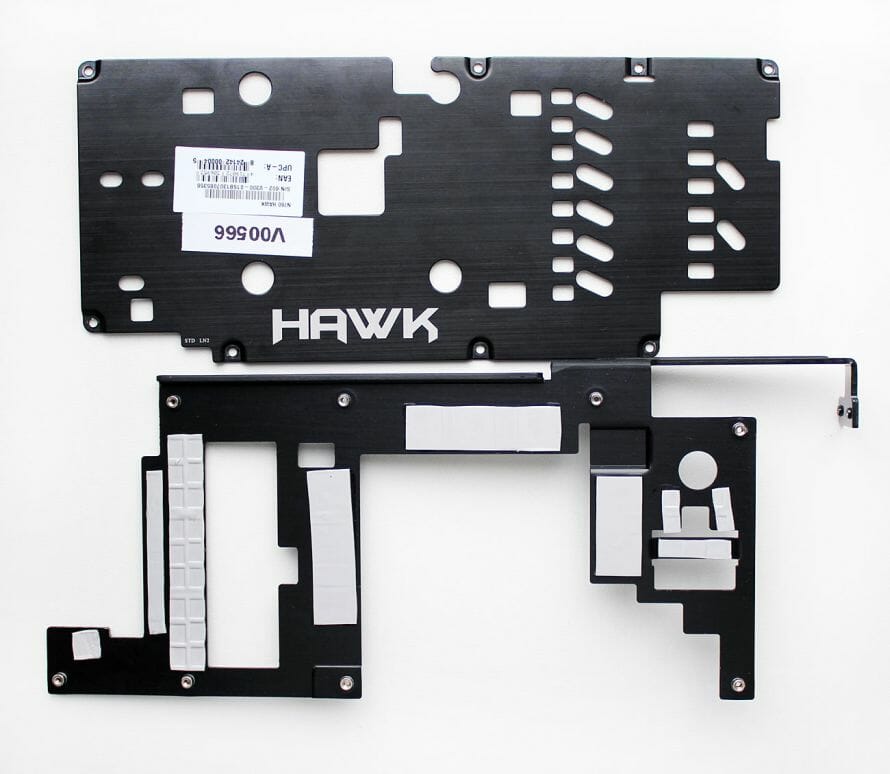
The heatsink features the so-called SuperPipes, actually. MSI claims they have twice the heat transfer speed compared to ordinary heat pipes. The cooler’s base is made of copper and nickel-plated, too.
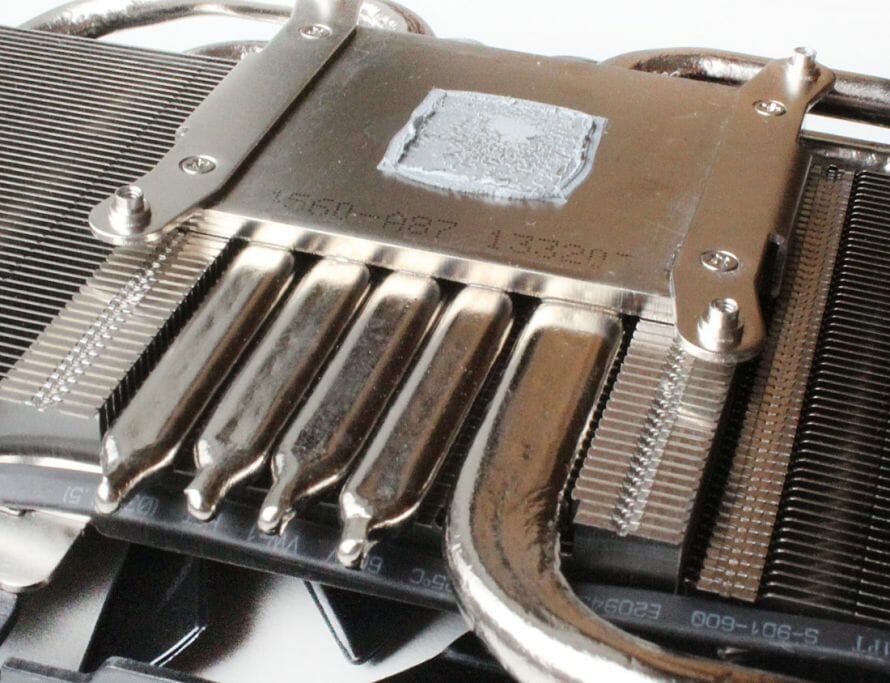
The aluminum fins and the heat pipes are soldered to each other:
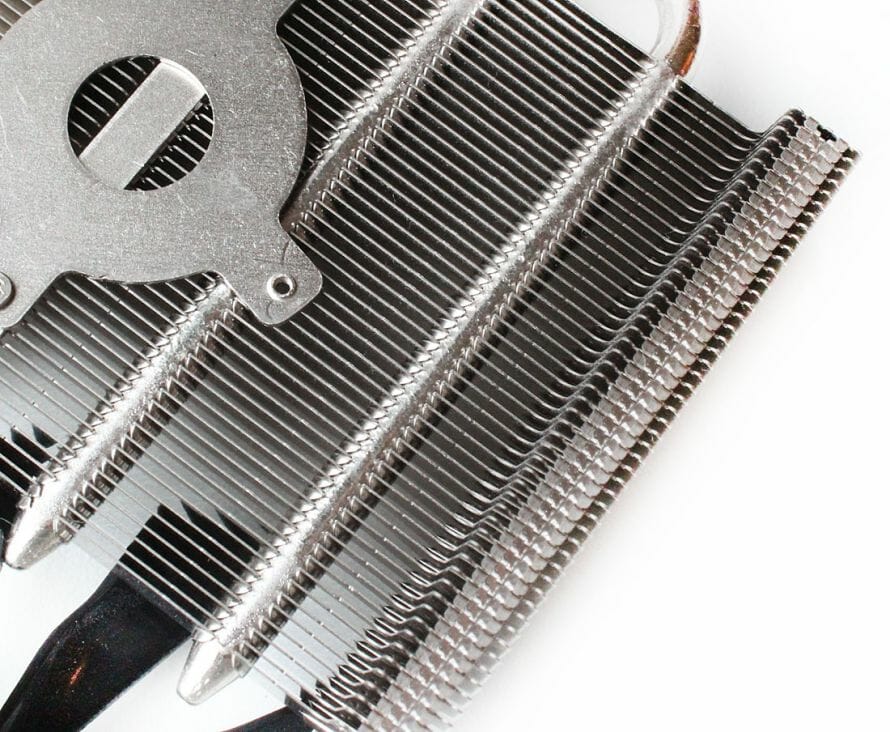
The cooler has two 100mm fans with Propeller Blade technology which ensures higher pressure at a lower level of noise. The fans also support Dust Removal technology (they rotate backwards for 30 seconds when shutting down to blow away the accumulated dust).
The fans are Power Logic’s PLD10010B12HH model.
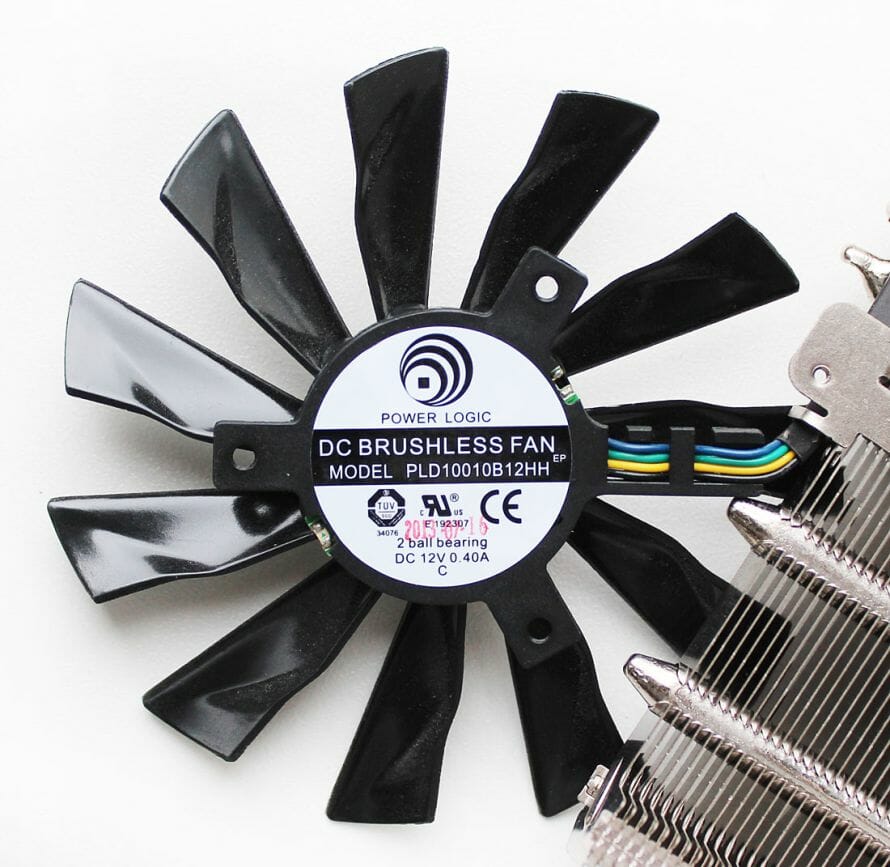
Their rotation speed is PWM-regulated in a range of 900 to 2850 RPM. There are two blue LEDs on each impeller for soft highlighting.
To check out the card’s temperature we used five runs of the Aliens vs. Predator (2010) benchmark at the highest visual quality settings, at a resolution of 2560×1440 pixels, and with 16x anisotropic filtering and withno 4x MSAA. We used MSI Afterburner 3.0.0 beta 14 and GPU-Z version 0.7.3 for monitoring of temperatures inside the closed system case, which configuration is discussed in detail in the following chapter of the review. All tests were performed at 20°C room temperature.
The Twin Frozr IV Advanced is almost perfect in terms of efficiency. In the automatic fan regulation mode the GPU was only 68°C hot and the fans rotated at less than 1300 RPM.
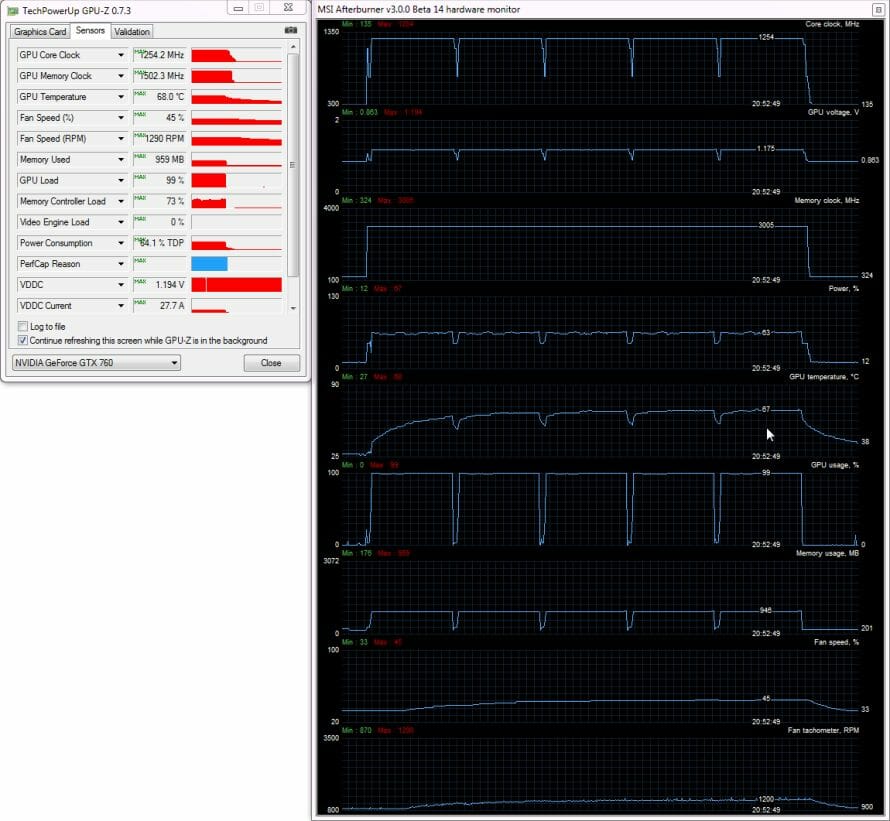
That’s a very good result for a pre-overclocked GK104. And if that’s not enough, you can set the fans at their maximum speed and lower the temperature down to 57°C.
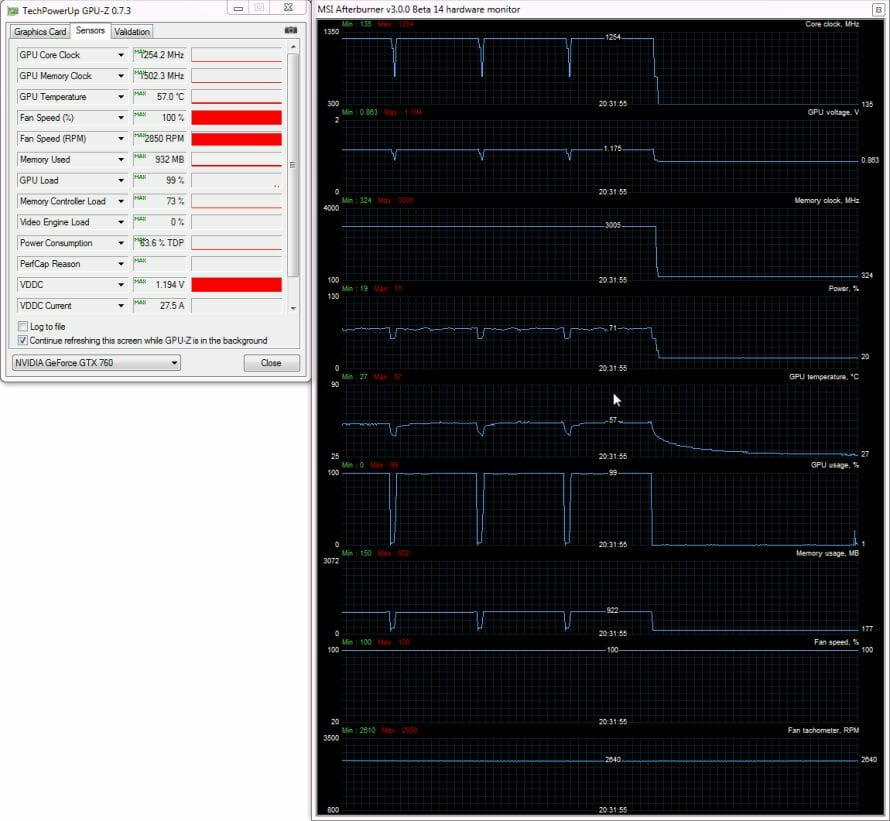
That’s just excellent. Now let’s see how noisy MSI’s cooler is.
The noise level of each cooler was measured between 1:00 and 3:00 AM in a closed room about 20 m2 big using CENTER-321 electronic noise meter. The noise level for each cooler was tested outside the system case when the only noise sources in the lab were the cooler and its fan. The noise meter was installed on a tripod and was always at a 150 mm distance from the cooler fan rotor. The tested cooling systems were placed at the edge of the desk on a sheet of polyurethane foam. The lowest noise reading our noise meter device can register is 29.8 dBA and the subjectively comfortable noise level in these testing conditions was around 36 dBA (do not mix it up with low noise level). The fan(s) rotation speed was adjusted in the entire supported range using our precise in-house controller by changing the voltage with 0.5 V increment.
For the comparison’s sake, the diagram also shows the noise level of the reference Nvidia GeForce GTX 760 and of the Palit GeForce GTX 760, which is equipped with an original JetStream cooler. The vertical dotted lines mark the peak speed of the coolers’ fans in the automatic speed regulation mode. Here’s the diagram:
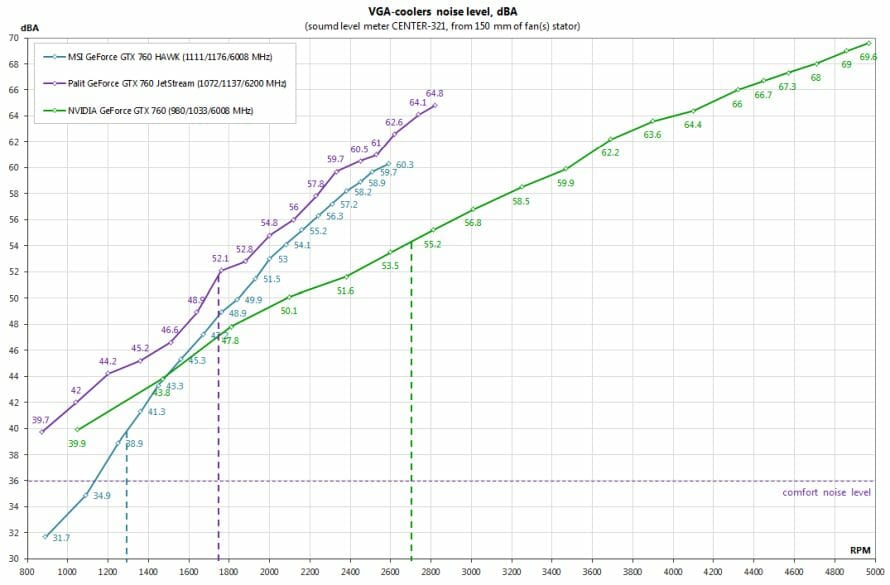
When the fans are regulated automatically, the MSI GeForce GTX 760 HAWK is the quietest of the three cards, and by a large margin at that. In 3D mode the MSI is audible against the background noise of a quiet computer, but it doesn’t become as annoying as the reference card or the Palit. In 2D applications the MSI is absolutely silent. So, the Twin Frozr IV Advanced is perfect in terms of both performance and noise level.
Overclocking Potential
Despite the pre-overclocked GPU, our sample of the MSI GeForce GTX 760 HAWK proved to have good overclocking potential. Without changing voltages, we increased its GPU frequency by an additional 80 MHz and its graphics memory frequency, by 1400 MHz.
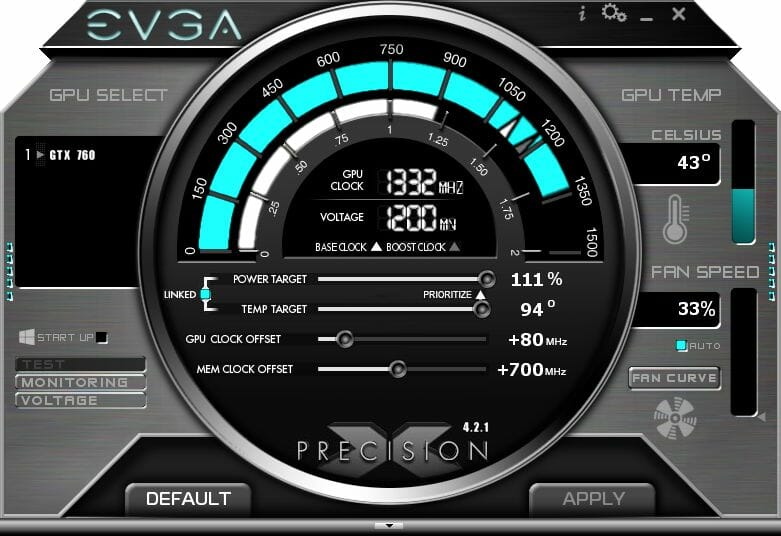
The resulting GPU clock rates were 1191/1256 MHz in 3D mode whereas the graphics memory worked at 7408 MHz.
That’s the best overclocking among all GeForce GTX 760s we’ve tested so far.
In the automatic fan regulation mode the peak GPU temperature of the overclocked card was only 4°C higher. The fans accelerated by a mere 90 RPM.
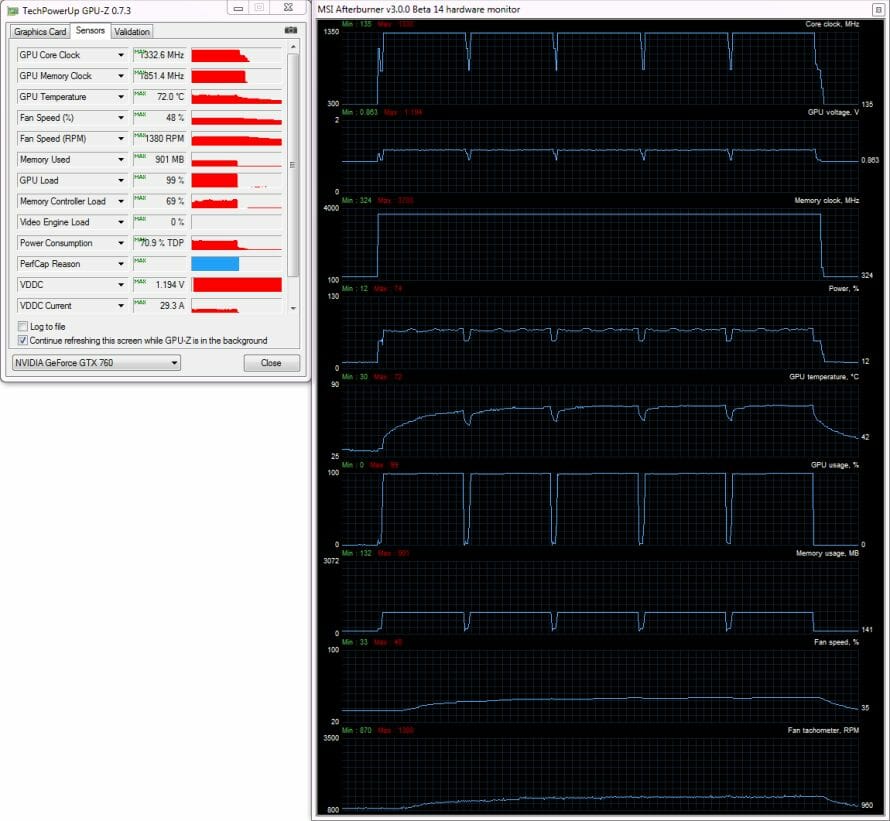
Such an excellent result can hardly be achieved with any other GeForce GTX 760.
Testbed Configuration and Testing Methodology
All participating graphics cards were tested in a system with the following configuration:
- Mainboard: Intel Siler DX79SI (Intel X79 Express, LGA 2011, BIOS 0559 from 03/05/2013);
- CPU: Intel Core i7-3970X Extreme Edition, 3.5/4.0 GHz (Sandy Bridge-E, C2, 1.1 V, 2 x 256 KB L2, 15 MB L3);
- CPU cooler: Phanteks PH-TC14PE (2 x Corsair AF140 fans at 900 RPM);
- Thermal interface: ARCTIC MX-4;
- Graphics cards:
- EVGA GeForce GTX 770 Superclocked ACX 2 GB(02G-P4-2774-KR) downclocked to 1046/1095/7012 MHz;
- MSI GeForce GTX 760 HAWK 2 GB 1111/1176/6008 MHz and 1191/1256/7408 MHz;
- NVIDIA GeForce GTX 760 2 GB 980/1033/6008 MHz;
- System memory: DDR3 4 x 8 GB G.Skill TridentX F3-2133C9Q-32GTX: 2133 MHz / 9-11-11-31 / 1.6 V;
- System drive: Crucial m4 256 GB SSD (SATA-III,CT256M4SSD2, BIOS v0009);
- Drive for programs and games: Western Digital VelociRaptor (300GB, SATA-II, 10000 RPM, 16MB cache, NCQ) inside Scythe Quiet Drive 3.5” HDD silencer and cooler;
- Backup drive: Samsung Ecogreen F4 HD204UI (SATA-II, 2 TB, 5400 RPM, 32 MB, NCQ);
- System case: Antec Twelve Hundred (front panel: three Noiseblocker NB-Multiframe S-Series MF12-S2 fans at 1020 RPM; back panel: two Noiseblocker NB-BlackSilentPRO PL-1 fans at 1020 RPM; top panel: standard 200 mm fan at 400 RPM);
- Control and monitoring panel: Zalman ZM-MFC3;
- Power supply: Corsair AX1200i 1200 W (with a default 120 mm fan);
- Monitor: 27” Samsung S27A850D (DVI-I, 2560×1440, 60 Hz).
In order to lower the dependence of the graphics cards performance on the overall platform speed, I overclocked our 32 nm six-core CPU with the multiplier set at 48x, BCLK frequency set at 100 MHz and “Load-Line Calibration” enabled to 4.8 GHz. The processor Vcore was increased to 1.38 V in the mainboard BIOS:
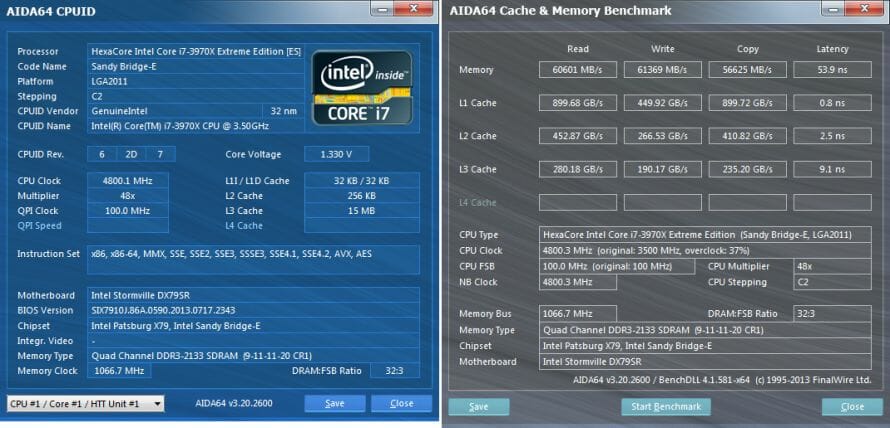
Hyper-Threading technology was enabled. 32 GB of system DDR3 memory worked at 2.133 GHz frequency with 9-11-11-31 timings and 1.6V voltage.
The test session started on Septemder 19, 2013. All tests were performed in Microsoft Windows 7 Ultimate x64 SP1 with all critical updates as of that date and the following drivers:
- Intel Chipset Drivers 9.4.3.1011 WHQL from 08/30/2013 for the mainboard chipset;
- DirectX End-User Runtimes libraries from November 30, 2010;
- Nvidia GeForce 327.23 WHQL driver for Nvidia based graphics cards;
We tested the graphics cards performance in two resolutions: 1920×1080 and 2560×1440. The tests were performed in two image quality modes: “Quality+AF16x” – default texturing quality in the drivers with enabled 16x anisotropic filtering and “Quality+ AF16x+MSAA 4x(8x)” with enabled 16x anisotropic filtering and full screen 4x or 8x antialiasing, in those cases when the average fps rate remained high enough for comfortable gaming experience. We enabled anisotropic filtering and full-screen anti-aliasing from the game settings. If the corresponding options were missing, we changed these settings in the Control Panels of Catalyst and GeForce drivers. We also disabled Vsync there. There were no other changes in the driver settings.
This time we are going to drop the old Metro 2033: The Last Refuge game from the list of benchmarks, since the new Metro: Last Light has already stepped in to completely replace it and has been updated to version 1.0.5. A few other games have also been updated. Now our benchmarking suite includes two popular semi-synthetic benchmarks and 13 resource-consuming games of various genres:
- 3DMark 2013 (DirectX 9/11) – version 1.0, benchmarks in “Cloud Gate”, “Fire Strike” and “Fire Strike Extreme” scenes;
- Unigine Valley Bench (DirectX 11) – version 1.0, maximum image quality settings, AF16x and(or) MSAA 4x, 1980×1080 resolution;
- Total War: Shogun 2: Fall of the Samurai (DirectX 11) – version 1.1.0, built-in benchmark (Sekigahara battle) at maximum graphics quality settings and enabled MSAA 8x in one of the test modes;
- Battlefield 3 (DirectX 11) – version 1.4, all image quality settings set to “Ultra”, two successive runs of a scripted scene from the beginning of the “Going Hunting” mission 110 seconds long;
- Sniper Elite V2 Benchmark (DirectX 11) – version 1.05, we used Adrenaline Sniper Elite V2 Benchmark Tool v1.0.0.2 BETA with maximum graphics quality settings (“Ultra” profile), Advanced Shadows: HIGH, Ambient Occlusion: ON, Stereo 3D: OFF, two sequential test runs;
- Sleeping Dogs (DirectX 11) – version 1.5, we used Adrenaline Sleeping Dogs Benchmark Tool v1.0.2.1 with maximum image quality settings, Hi-Res Textures pack installed, FPS Limiter and V-Sync disabled, two consecutive runs of the built-in benchmark with quality antialiasing at Normal and Extreme levels;
- Hitman: Absolution (DirectX 11) – version 1.0.446.0, built-in test with Ultra image quality settings, with enabled tessellation, FXAA and global lighting;
- Crysis 3 (DirectX 11) – version 1.2.0.1000, all graphics quality settings at maximum, Motion Blur amount – Medium, lens flares – on, FXAA and MSAA4x modes enabled, two consecutive runs of a scripted scene from the beginning of the “Swamp” mission 110 seconds long;
- Tomb Raider (2013) (DirectX 11) – version 1.1.743.0, we used Adrenaline Benchmark Tool, all image quality settings set to “Ultra”, V-Sync disabled, FXAA and 2x SSAA antialiasing enabled, TessFX technology activated, two consecutive runs of the benchmark built into the game;
- BioShock Infinite (DirectX 11) – version 1.1.21.65455, we used Adrenaline Action Benchmark Tool v1.0.2.1, two consecutive runs of the built-in benchmark with “Ultra” and “Ultra+DOF” quality settings;
- Metro: Last Light (DirectX 11) – version 1.0.5, we used built-in benchmark for two consecutive runs of the D6 scene. All image quality and tessellation settings were at “Very High”, “Advanced PhysX technology was enabled, we tested with and without SSAA antialiasing;
- GRID 2 (DirectX 11) – version 1.0.82.8704, we used built-in benchmark, graphics image quality settings were at their maximum in all aspects, the tests were run with and without MSAA 8x antialiasing with eight cars on the Chicago track;
- Company of Heroes 2 beta (DirectX 11) – version 3.0.0.9804, two consecutive runs of the integrated benchmark at maximum image quality and physics effects settings;
- Total War: Rome II (DirectX 11) — version 1.0.0.1, Extreme quality, V-Sync disabled, SSAA enabled, two consecutive runs of the integrated benchmark;
- ArmA III (DirectX 11) — version 1.0.109911, we used ArmA3Mark benchmark, Ultra quality, V-Sync disabled, two consecutive runs of the integrated benchmark.
If the game allowed recording the minimal fps readings, they were also added to the charts. We ran each game test or benchmark twice and took the best result for the diagrams, but only if the difference between them didn’t exceed 1%. If it did exceed 1%, we ran the tests at least one more time to achieve repeatability of results.
Performance
We will compare the performance of the pre-overclocked MSI GeForce GTX 760 HAWK with that of the reference card from Nvidia. We will also check out if the overclocked HAWK can catch up with a standard GeForce GTX 770. Since we have the same standings in each of our tests, we won’t analyze the particular games or benchmarks. We’ll just show you our performance summary charts.
Crysis 3
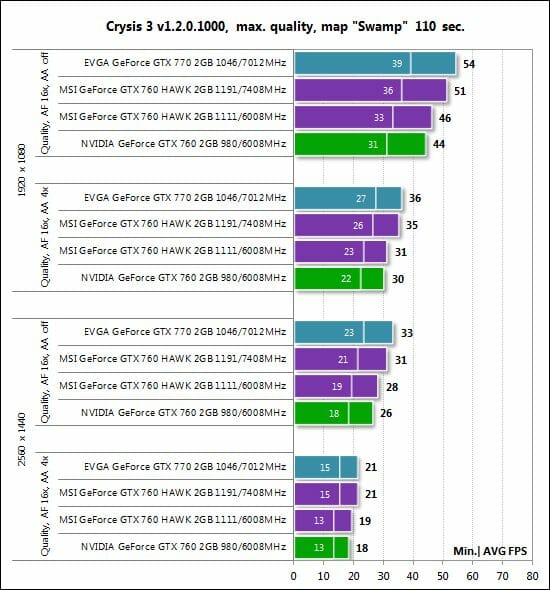
Tomb Raider (2013)
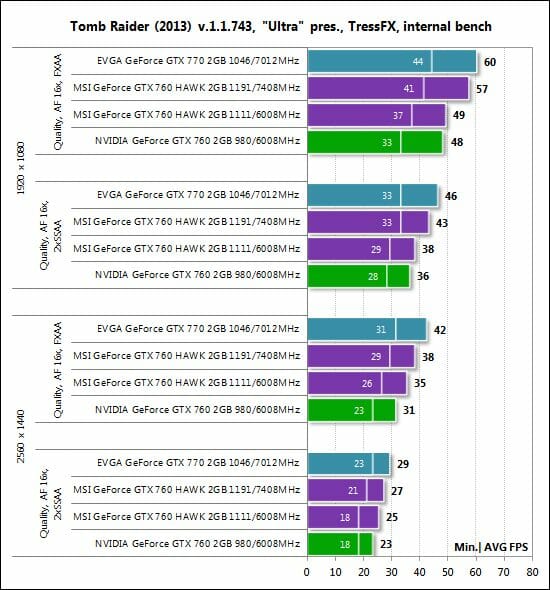
BioShock Infinite
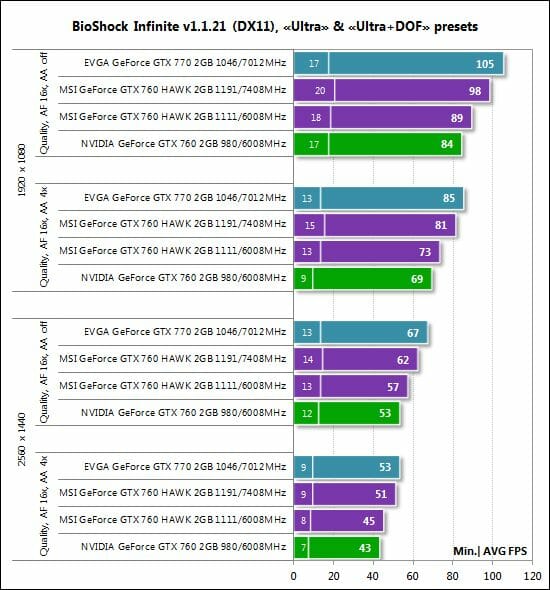
Metro: Last Light
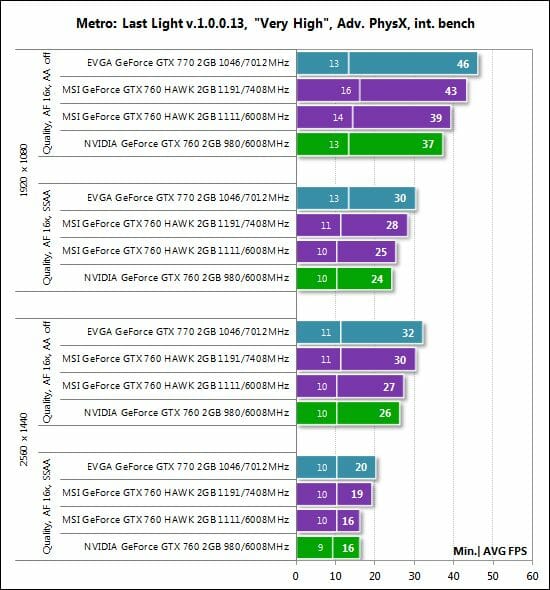
GRID 2
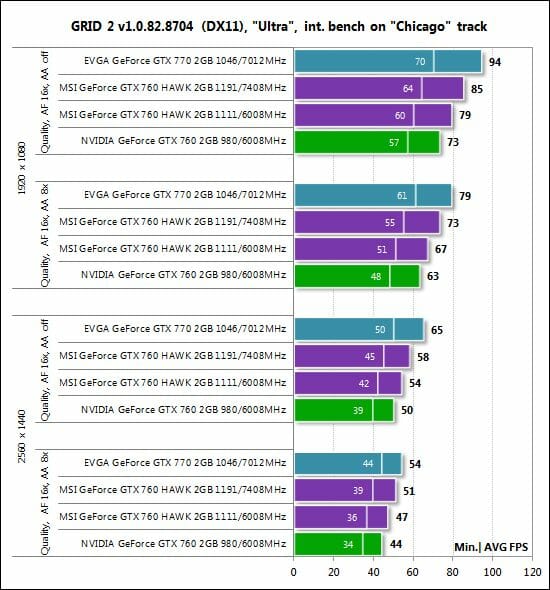
Company of Heroes 2
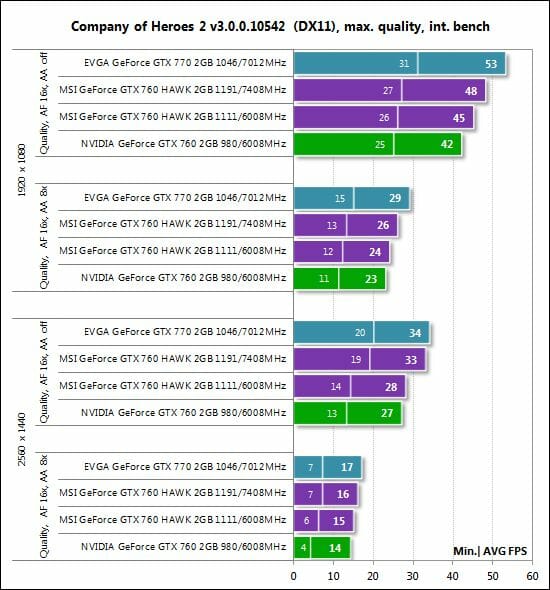
Total War: Rome II
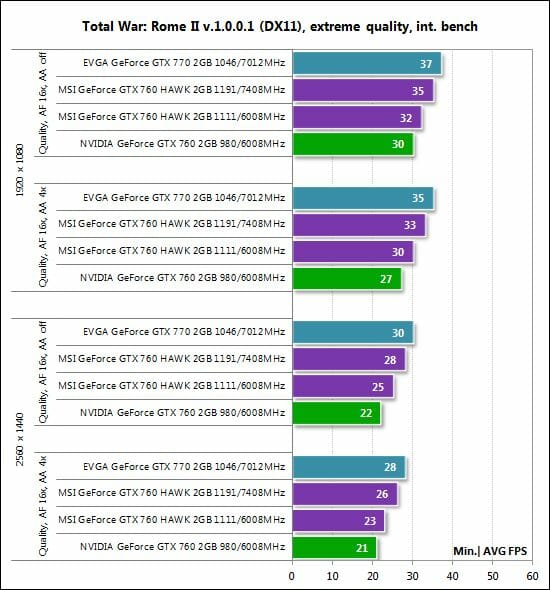
ArmA III
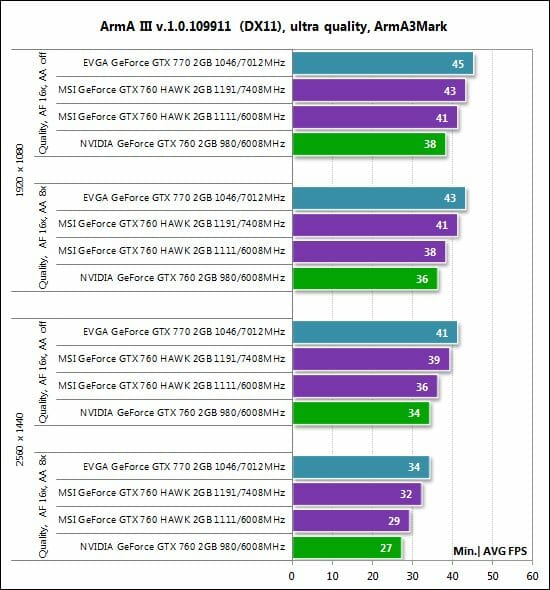
The first pair of our charts helps compare the MSI GeForce GTX 760 HAWK and the reference GeForce GTX 760:
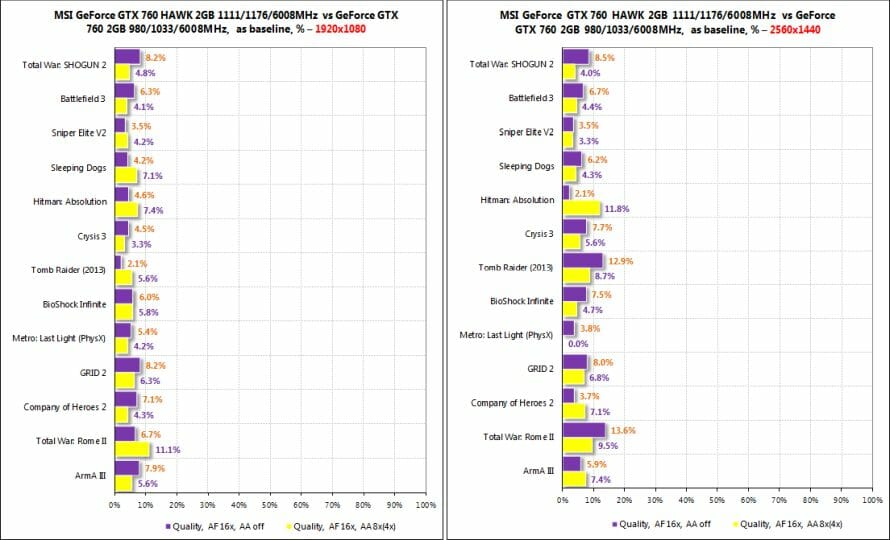
The MSI version is an average 6% faster than the reference card at 1920×1080 and 6 to 7% faster at 2560×1440.
The overclocked HAWK is compared with the reference GeForce GTX 770 in the next pair of diagrams:
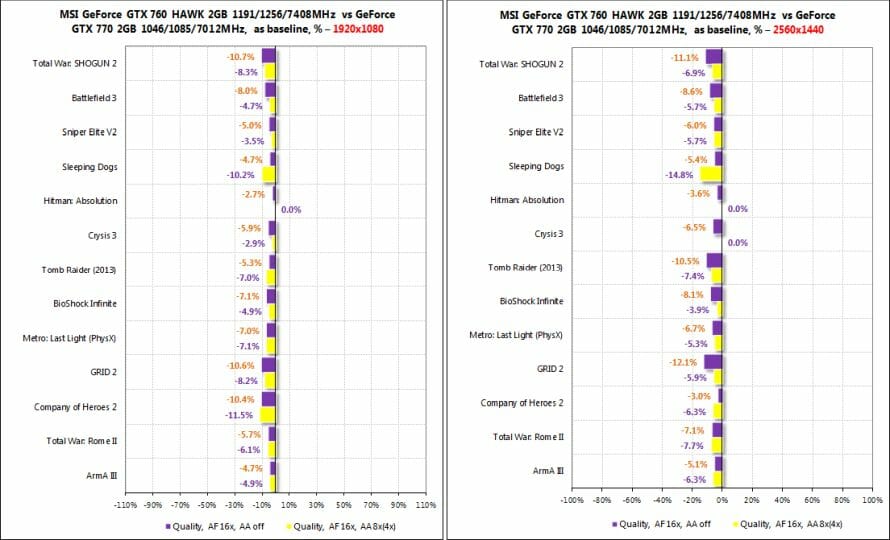
As you can see, the MSI GeForce GTX 760 HAWK cannot beat the higher-class card even when seriously overclocked. The gap is small, however. The HAWK is 6-7% behind at the resolution of 1920×1080 and 5-7% behind at 2560×1440. In some games the two graphics cards are no different at all thanks to the MSI’s good memory overclocking.
Conclusion
The MSI GeForce GTX 760 HAWK is a hawk song for MSI’s GTX 760 product series. It is the uncompromisingly best version of the GeForce GTX 760 and is obviously the last in its series. Featuring military-grade components, dual BIOS, voltage check points, a pre-overclocked GPU and a highly efficient and very quiet cooler Twin Frozr IV Advanced, the MSI GeForce GTX 760 HAWK is a perfect mainstream product that is going to be interesting for extreme overclockers as well as for people who value silence.
We guess it can satisfy any demanding user and is certainly worth the price difference from the reference GeForce GTX 760. That’s why we recommend the MSI GeForce GTX 760 HAWK as the perfect midrange gaming graphics card for any user.